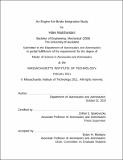| dc.contributor.advisor | Zoltan S. Spakovszky. | en_US |
| dc.contributor.author | Mulchandani, Hiten | en_US |
| dc.contributor.other | Massachusetts Institute of Technology. Dept. of Aeronautics and Astronautics. | en_US |
| dc.date.accessioned | 2011-05-23T15:31:02Z | |
| dc.date.available | 2011-05-23T15:31:02Z | |
| dc.date.copyright | 2011 | en_US |
| dc.date.issued | 2011 | en_US |
| dc.identifier.uri | http://hdl.handle.net/1721.1/62880 | |
| dc.description | Thesis (S.M.)--Massachusetts Institute of Technology, Dept. of Aeronautics and Astronautics, 2011. | en_US |
| dc.description | This electronic version was submitted by the student author. The certified thesis is available in the Institute Archives and Special Collections. | en_US |
| dc.description | Cataloged from student submitted PDF version of thesis. | en_US |
| dc.description | Includes bibliographical references (p. 109-112). | en_US |
| dc.description.abstract | The feasibility of operating an engine air-brake (EAB) integrated with a pylon duct bifurcation in a realistic aircraft engine environment has been analyzed. The EAB uses variable exit guide vanes downstream of a high bypass ratio (BPR) fan rotor to produce drag quietly by swirling flow out of the fan nozzle. The swirling motion yields low pressure in the vortex core from simple radial equilibrium, thereby generating pressure drag. The 4-BB internal plug and 5-BB external plug nozzles of BPR 8 are chosen to provide a realistic environment for model-scale tests at the NASA Aero-Acoustic Propulsion Lab (AAPL). The objectives of this study are to quantify the impact of a pylon on the drag and noise of an EAB, and explore means to mitigate the potential loss of swirling flow and associated drag. Analysis is conducted at approach conditions on the 4-BB nozzle, with fan and core nozzle pressure and temperature ratios obtained from an engine cycle analysis. A pylon is designed to represent engine installations typically encountered in short-range jet aircraft. The pylon is a prismatic NACA 0012 airfoil geometry with swept leading, trailing edges and an extended internal fairing to facilitate compatibility with both nozzles in the AAPL facility. The EAB cases analyzed include three types of pylon/vane configurations: (1) the baseline pylon with un-deflected swirl vanes is used in the calculation of the equivalent drag coefficient (CD); (2) the pylon with the trailing edge (TE) flap deflected full-span by 35 degrees is used to set structural load limits for detailed design of the baseline pylon; and (3) configurations with the pylon TE flap deflected partial-span by 20 degrees and asymmetric swirl vanes are used to generate swirling outflow from the fan nozzle exhaust. The partial-span deflection cases are further categorized by the location of the asymmetric vanes: at the nozzle exhaust (aft) and further upstream. Computational results demonstrate the aft vanes generate CD in the range 0.35-0.61 and the upstream vane cases produce CD between 0.09-0.18. The difference in drag is because the flow avoids the majority of the duct bifurcation in the aft vanes cases to produce stronger swirling outflow. A CD value between 0.7-1.0 is required to achieve a 3-4 degree glidescope change and therefore an overall noise benefit of 2.5 dB for a conventional tube-and-wing aircraft on approach. The aft vane configurations show promise in reaching this target while the upstream vane installation concepts require further investigation. | en_US |
| dc.description.statementofresponsibility | by Hiten Mulchandani. | en_US |
| dc.format.extent | 112 p. | en_US |
| dc.language.iso | eng | en_US |
| dc.publisher | Massachusetts Institute of Technology | en_US |
| dc.rights | M.I.T. theses are protected by
copyright. They may be viewed from this source for any purpose, but
reproduction or distribution in any format is prohibited without written
permission. See provided URL for inquiries about permission. | en_US |
| dc.rights.uri | http://dspace.mit.edu/handle/1721.1/7582 | en_US |
| dc.subject | Aeronautics and Astronautics. | en_US |
| dc.title | An engine air-brake integration study | en_US |
| dc.type | Thesis | en_US |
| dc.description.degree | S.M. | en_US |
| dc.contributor.department | Massachusetts Institute of Technology. Department of Aeronautics and Astronautics | |
| dc.identifier.oclc | 722797429 | en_US |
